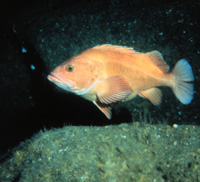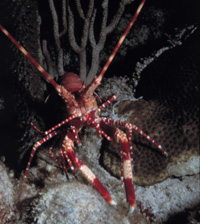![[Currents header graphic]](/homeart/currents_header.gif)
![[Currents header graphic]](/homeart/currents_header.gif)
February 16, 1999
By Tim Stephens
A consortium of marine scientists from UCSC and three other major universities in California and Oregon has received a grant of $17.7 million from the David and Lucile Packard Foundation to conduct ecological research aimed at improving the conservation of marine ecosystems.

|
|
The Packard grant will fund research into interactions of marine organisms such as rockfish (above) and rock lobster (below). |

|
|
Photos courtesy of OAR/National Undersea Research Program
|
The Partnership for Interdisciplinary Studies of Coastal Oceans (PISCO) brings together four leading centers of marine science research on the West Coast: UCSC, UC Santa Barbara, Stanford University, and Oregon State University (OSU). By combining their strengths, PISCO will enable researchers at these institutions to conduct coordinated studies of coastal ecosystems on an unprecedented scale.
A major focus of the group's efforts will be to study the movements and interactions of fish and other marine organisms over a 1,200-mile (2,000-kilometer) stretch of coastal waters from Oregon to southern California, said Peter Raimondi and Mark Carr, assistant professors of biology at UCSC and two of the principal investigators on the project.
"This partnership allows us to look at marine ecological processes at the scales at which things really happen," Raimondi said.
The five-year interdisciplinary project will involve researchers from diverse fields working toward an integrated picture of the coastal environment and ecosystems. PISCO will establish a coordinated monitoring network to track nearshore ecological patterns along the coast. This is the first time such an extensive interdisciplinary effort has been undertaken to study the nearshore zone, which extends out to six miles (ten kilometers) from shore, said Jane Lubchenco, one of OSU's two principal investigators on the project.
"For the first time, we will have insight into the dynamics of a scientific netherworld, the zone from zero to ten kilometers off shore. It is precisely this nearshore zone that is being strongly affected by a broad spectrum of human activities," Lubchenco said.
Marine conservation and fisheries management efforts will benefit directly from the data gathered by PISCO, said Carr. By studying the dynamics of coastal ecosystems along the West Coast, the researchers aim to establish a scientific basis for the effective design, monitoring, and evaluation of marine reserves and other conservation measures.
With OSU in the north, UCSC and Stanford's Hopkins Marine Station on the Central Coast, and UCSB in southern California, PISCO researchers are well situated to look at the linkages between different communities of fish, invertebrates, and algae over a broad geographic area. This type of research is critical for understanding the ecological processes in the nearshore environment, Carr said.
"Historically, we've only been able to study these issues on a small scale, and we don't know very much about how populations in one area are influenced by other populations," he said. "With rockfish, for example, the youngest fish in the populations here on the Central Coast are the offspring of adults living somewhere else. So management decisions made up north can have direct implications for populations down here. The same is true for many other species."
Raimondi and Carr will head UCSC's participation in the partnership. The Center for Ocean Health, recently funded by a $5 million grant from the Packard Foundation, will be the focal point for much of the UCSC component of PISCO. Raimondi and Carr will draw on the expertise of UCSC faculty in a broad range of disciplines, who will be affiliated with PISCO as senior fellows. These will include physical and chemical oceanographers such as Kenneth Bruland, professor of ocean sciences, marine biologists such as John Pearse, professor emeritus of biology, and ecologists such as Marc Mangel, professor and chair of environmental studies, and James Estes, a marine ecologist with UCSC and the U.S. Geological Survey.
OSU, UCSB, and UCSC will coordinate PISCO's ecological monitoring and experimental research programs and will also provide new leadership in policy outreach. Stanford will coordinate laboratory research on physical, biomechanical, and physiological mechanisms and will develop an interdisciplinary training course in advanced scientific techniques.
"Our group at UCSC will be working intimately with researchers at the other institutions," Raimondi said. "We will also be working closely with the Monterey Bay National Marine Sanctuary and the Monterey Bay Aquarium Research Institute to exchange information and resources," he added.
A policy outreach program is included in PISCO's plans to ensure that the scientific knowledge gathered by researchers is effectively communicated to the public and policy makers and that the scientists are designing their research to answer questions of interest to these groups. An annual symposium is planned as part of this effort.
"It's especially important that whatever we find out be used immediately to develop sound environmental and social policies," Lubchenco said. "Towards that goal, the consortium will work closely with natural resource policy makers, communicate with the general public through open forums and the news media, and get our scientists both involved and trained in communicating their findings."
In addition to Lubchenco, Raimondi, and Carr, the principal investigators in the PISCO consortium include Bruce Menge at OSU, Steven Gaines and Robert Warner at UCSB, and George Somero and Mark Denny at the Hopkins Marine Station of Stanford University.
The David and Lucile Packard Foundation, based in Los Altos, is a private family foundation established in 1964. It provides grants in several major program areas, including science, population, conservation, arts, and children and community.